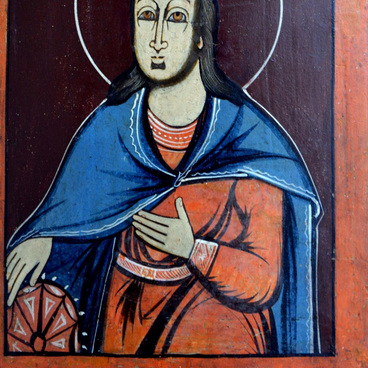In Christian art, Christ Pantocrator (“The Almighty”) is one of the main types of iconographic depiction of Christ. In church frescoes, “Pantocrator” is usually featured on the vault of the main dome (as the pinnacle of the heavenly hierarchy), as well as above the entrance to the church. This iconographic type (even without naming the image with the appropriate inscription) originated in the early Christian art in the Roman Empire. One of the earliest icons of this type has been preserved in the St. Catherine’s Monastery at Sinai, dating from the 6th century AD.
Christ the Almighty is usually presented as a middle-aged man with a beard, wearing a purple tunic and a blue himation. This iconographic type includes waist-length and full-length images, as well as those depicting Jesus Christ on the throne. He holds the Gospel in His left hand and the right hand is raised in a blessing. In shoulder-length images, these attributes are not present.
The exhibition presents a shoulder-length image of the Almighty — a characteristic monument of Russian religious art. It was created by icon painters of the 19th century, possibly Old Believers who did not accept new approaches in icon painting, or other innovations of the followers of Patriarch Nikon’s church reform.
The Lord wears a purple chiton and a blue himation; the former is covered with shining golden rays, while the folds of latter are masterfully accentuated with highlights that enhance the decorative elements of the image. The face of the Savior is carefully executed. The outline of the face is painted with a brown sankir. The mid-face and illuminated parts are emphasized by a soft addition of paint strokes that are almost liquid and “melt” into one another (a technique called plav — “melting” — that makes the image look lighter). In addition to using the “melting” paint stokes, the icon painter enlivened the most prominent and emotionally significant facial features with elegant dashes — “ozhivki” — that make the image even more vivid.
The face of Christ, in accordance with iconographic laws (these are instructions containing rules and patterns of painting icons), is of a regular oval shape, with a high forehead, large, attentively and strictly looking eyes; a narrow, elongated nose and small, pursed lips. The hair is distinguished by prominent decorative features: each strand of hair is painted separately, but at the same time all together they form a wave gracefully falling on the shoulders.
Around the face is a cruciform halo against an
olive background, which in turn is enclosed in darker fields of an
ocherish-olive shade.


